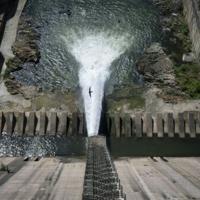Listen to the article
Spanish internet spaces have seen a recent surge of misinformation regarding Francisco Franco’s legacy, with numerous false claims about the dictator’s contributions to Spain’s development circulating widely on social media platforms.
Many of these misleading narratives focus on infrastructure projects, attributing Spain’s network of dams, highways, and housing developments almost exclusively to Franco’s 36-year rule from 1939 to 1975. One particularly persistent claim suggests Franco’s regime constructed over a thousand dams, single-handedly transforming Spain’s water management capabilities.
Historians and fact-checkers have consistently debunked these exaggerations. While approximately 300 dams were indeed built during the dictatorship, Spain’s hydroelectric development began well before Franco’s rise to power and continued after his death. The most significant expansion of Spain’s water infrastructure actually occurred during Spain’s democratic era, with hundreds of dams constructed after 1975.
“This represents a classic case of attribution bias,” explains Dr. Elena Martínez, professor of Contemporary Spanish History at Universidad Complutense de Madrid. “Long-term infrastructure projects that spanned multiple eras are being credited entirely to the Franco regime, ignoring both previous foundations and subsequent developments.”
Similar distortions appear in claims about Spain’s social security system. Franco-era nostalgists frequently assert that the dictator established Spain’s pension system, when in fact the foundations were laid during the Second Republic in the 1930s, before Franco’s rule. What the regime did implement was a limited, contribution-based system that fell well short of comprehensive coverage.
Housing represents another area rife with misinformation. Social media posts frequently circulate that Franco built over a million affordable homes for workers. While housing construction did accelerate during the 1960s, this coincided with Spain’s economic opening and was largely driven by private investment and remittances from Spanish workers abroad rather than direct government funding.
“The regime certainly publicized these developments extensively through propaganda channels, creating an association between housing progress and Franco’s leadership,” notes urban historian Carlos Sánchez of the University of Barcelona. “But the economic reality was more complex, with international capital and market forces playing crucial roles.”
Digital platforms have proven particularly fertile ground for such historical revisionism. Facebook groups, YouTube channels, and Twitter accounts dedicated to rehabilitating Franco’s image regularly share these claims, often accompanied by black-and-white photographs of infrastructure projects or housing developments.
The persistence of such misinformation reflects Spain’s ongoing struggle to reckon with its authoritarian past. Unlike other European nations that experienced fascist rule, Spain underwent a negotiated transition to democracy that avoided explicit condemnation of the previous regime. This “pact of forgetting” left space for competing historical narratives to flourish.
Recent political polarization has intensified the spread of Franco-era myths. Far-right parties have gained electoral ground in Spain, coinciding with increased challenges to the 2007 Historical Memory Law that sought to address Franco’s legacy and honor victims of the regime.
“We’re seeing a concerted attempt to rehabilitate aspects of the dictatorship by focusing selectively on material developments while downplaying the regime’s severe human rights abuses,” says Miguel Torres, director of the Foundation for Democratic Memory.
Fact-checking organizations have responded by creating dedicated resources to counter Franco-era disinformation. These efforts include databases of infrastructure projects with accurate timelines and comprehensive explainers about Spain’s economic development across different political periods.
Experts emphasize that understanding this history accurately requires acknowledging both continuities and changes across different eras. Many projects attributed solely to Franco were actually conceived before his regime or completed after his death, often with significantly modified plans.
“Historical truth requires nuance,” Dr. Martínez concludes. “Spain’s development story isn’t about a single leader or period, but rather about a complex interplay of factors spanning multiple generations—something that simplistic social media narratives rarely capture.”
Fact Checker
Verify the accuracy of this article using The Disinformation Commission analysis and real-time sources.




6 Comments
The article highlights an important issue in how we evaluate the legacies of past leaders – the tendency to oversimplify and exaggerate their contributions, especially when it comes to large-scale infrastructure projects. Maintaining historical accuracy is crucial.
Interesting to see how disinformation can distort the historical facts around infrastructure development. It’s important to rely on authoritative sources when evaluating claims about past regimes.
The article highlights an important issue – the tendency to overly credit authoritarian leaders for infrastructure projects that began before and continued after their rule. Careful analysis is needed to separate myth from reality.
Absolutely, we shouldn’t let nationalist narratives blind us to the full context and timeline of major public works. Fact-checking is crucial to maintain an accurate understanding of history.
This kind of disinformation seems aimed at whitewashing the Franco regime’s legacy. It’s concerning to see these false claims spreading online. We must be vigilant in challenging such revisionist narratives with evidence-based analysis.
It’s troubling to see how disinformation can distort the public’s understanding of a country’s history and the role of its past leaders. Rigorous fact-checking and reliance on authoritative sources are essential to counter these misleading narratives.